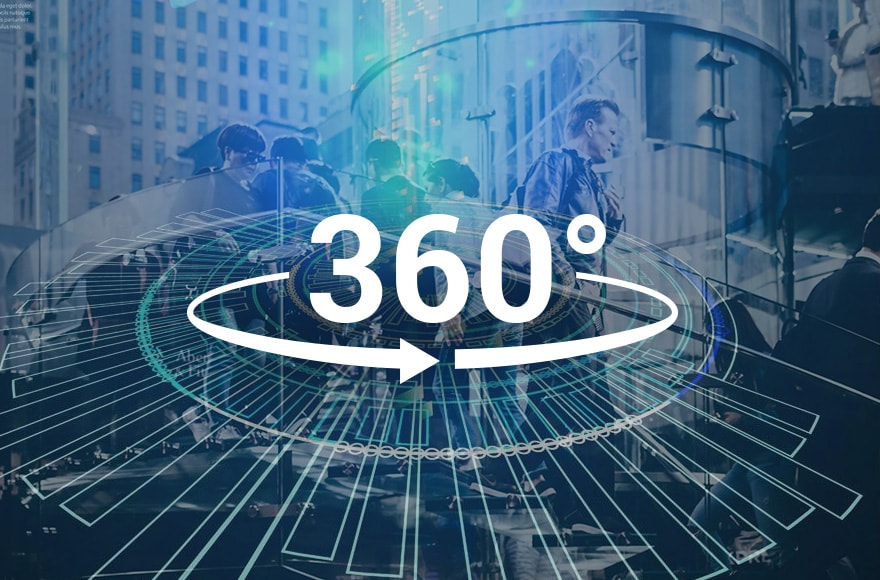Thousands of mobile apps (both Android and iOS) are published every day covering areas such as eCommerce, eHealth, social networking, mobile gaming, and more. However, regardless of the product niche or platform, the app development cycle often follows a standard operation.
This remains true even when methodologies evolve over time. At Intersog, we have been building cutting-edge mobile apps for over 12 years and they were all developed following a similar process:
- The idea for the mobile application
- A clearly defined strategy
- User Experience (UX) design
- User Interface (UI) design
- Technical development cycle
- Quality Assurance (QA) Testing
- Product deployment
Your Mobile App Idea
Every great app starts with an idea that solves a real-world problem. This process usually starts with reviewing the apps that are currently in the marketplace to ascertain if anything could have been done better.
It’ll be even better if you can identify a gap in the market or a problem that hasn’t been solved yet. However, once you have an idea, you shouldn’t just jump into building an app.
You have to first have a complete understanding of the problem and then figure out why no one else has come up with a solution (before you did!). This approach usually helps to build a business model that can generate revenue.
Once you get past this stage, you can map out how exactly your mobile app will efficiently solve this problem. If you have a clear understanding of how mobile apps work, you’ll be able to figure out the viability and validity of your idea before you start prototyping your future solution.
Developing a Clearly Defined Strategy

People download mobile apps on a daily basis, but more often than not, they’re quickly abandoned. As a result, this makes it important to develop a strong strategy that can help ensure success.
But how do you do this?
1. Define Your Business Goals
It all starts with clearly defining your business goals. You can do this by starting with your overall businesses objectives and clearly breaking it down for analysis, documentation, and evaluation (like profit margins, improved ratings, market expansion, etc.).
2. 360° Assessment
Next, conduct a 360° assessment of the industry and identify your competition. Once you have completed your 360° assessment, you’ll be ready to compare your findings with your own business model and clearly define the best way forward.
As a rule, remember that it’s always better to innovate rather than playing catch up!
3. Mobility Goals
This is also the perfect time to define your mobility goals and determine the best platform for your app (and you can choose from native, cross-platform native, hybrid, or progressive web app).
It’s important to make these decisions while keeping an eye on the future to achieve the maximum ROI before the inevitable change to the technology landscape.
4. Marketing and Enterprise Integration
When strategizing marketing and enterprise integration, you have to make sure that it includes the following:
- Project requirements
- Data analytics setup and reporting
- ERP/Application/Database integrations
- Internal and external supplier requirements
- Mobile Device Management/Mobile Application Management/Unified Endpoint Management
- Security
At this point, you should also know what it would take for your app to be successful. This means considering the factors that can help ensure success soon after its published and in the near future.
In other words, your MVP should come with a vision and should be ranked according to priority. This is also a good time to find answers to questions like the following:
- How will you attract new users?
- How will you keep them coming back?
- What are the core functionalities required to achieve it?
UX Design
Information Architecture
As UX design will play a critical role in the success of your app, it’s best to start with information architecture. This means that you have to map out what data and functionality will be presented within the app and how it will be organized.
We usually approach this by writing down the list of features and functions that the app will perform and what will be displayed in the UI. At the same time, we also consider five UX design triggers that can help capture users and increase sales:
- Achievement (by providing challenges and meaningful rewards)
- The bandwagon effect (by giving the impression that there’s a lot of hype surrounding the app)
- Chunking (by breaking down information into small blocks or sections)
- The Zeigarnik effect (to gain some control over user behavior)
- Visual metaphors (to demonstrate similarities or differences between two or more things)
Wireframes and Workflows
Once you’re ready, start building the wireframes for the app (which is a lot like developing screens and assigning data and related functions to each). It will save you a lot of money if changes are made now rather than later, so it’s important to invest a significant amount of time and effort into this activity.
Once all the app screens are drawn up, you have to start thinking about the workflows. Workflows will help you get a clear idea of what your users will see and the number of clicks it will take to complete any specific action.
This will be a great opportunity to ensure that every click is intuitive. More often than not, you will find problems with your workflows. For example, you might realize that you could have avoided multiple clicks to complete a simple operation if it was approached in a different way.
However, when you make adjustments, make sure that it’s also reflected in your wireframes. The idea here is to make your app highly user-friendly as this will increase your chances of getting the end-user to keep coming back.
Click-Through Model
To test your wireframes and workflows, we usually use a click-through model. This provides a real-world view of how your app will look and feel on a smartphone.
Although the app won’t have any real functionality, it’s a great way for all stakeholders to test the app’s navigation and its general look and feel.
Again, if any issues come up at this stage, update your wireframes to reflect your changes and iterate until everyone is completely satisfied. At this point, it’s a good idea to encourage extensive feedback from everyone who checks it out.
UI Design
Style Guides
The app’s usability will be closely tied to a solid style guide which is basically the building blocks of the design. The rule here is to ensure consistency in the design language and synchronicity throughout all the app’s pages.
Before you can decide on the app’s style guide, you have to take your target audience and their behavior into consideration.
Will they be using the app at work? If so, it’s best to keep it clutter free and simple. Will they be using the app during the day? If so, a light theme will be better suited.
Regardless of what you choose to go with, the key here is to make it a simple as possible to communicate your main objective.
An experienced designer or design team can be a great asset for a mobile development project as their experience can help you quickly decide on the following:
- Color pallet
- Fonts
- Widgets
When making these decisions, it’s important to ensure that your choices are perfectly suited to your brand and target audience.
Rendered Designs and Click-Through Models
When we render designs, we’re simply replacing the grayscale elements of the wireframe with the elements and themes from the style guide. This means that there should be a rendered screen for each wireframe screen.
If you decide that you’re not happy with something, you can still make changes. However, it’s important to remember that these changes should be consistent.
Once this process is complete, you can go back to the click-through model and start testing it all over again. This part of the development cycle shouldn’t be rushed because any changes you make (going forward) can add to your final development costs.
Once you’re happy with what you have, you’ll be ready to hand it over to the app development team to start coding. If you’re outsourcing this mobile app development project, it’ll be wise to go with a company that offers both design and development services to ensure that your vision is properly realized sooner rather than later. In our experience, there’s a lot less conflict between design teams and development teams when they’re all working for the same company.
Technical Development Cycle
There are multiple technologies, programming languages, and approaches to building mobile apps. Each has its own pros and cons, so you have to evaluate what’s best for everyone involved in the project.
The key here is to build the app with a technology stack that’s not only highly reliable but also one that’s going to be around for years to come.
Getting this part right will save you a lot of money in the long run, so if you’re going to engage a third-party developer, make sure that they have a good track record of making these decisions.
Front-End Development
When it comes to front-end development, you’ll have to choose between four approaches:
- Native (Android or iOS)
- Cross-platform native (built with shared code, but run natively)
- Hybrid (built with web technologies like HTML, CSS, and Javascript)
- Progressive Web App (a combination of the best web experiences and app experiences)
Back-End (Web API and Server)
The mobile app’s performance and scalability will depend on the server. This makes it important to make some key decisions before writing any code.
First, you have to choose from dozens of programming languages to build your API. Next, you’ll have to choose between databases such as SQL, NoSQL, etc.
It’s important to have organized and reliable data to ensure success in the long term so it’ll pay off to take the time and make educated decisions. At this juncture, you’ll also have to choose where you’re going to host your app.
The technical development cycle can follow different approaches. At Intersog, we often choose to develop apps using the agile approach. This means that the project can be broken down into little chunks where the app’s built in a series of cycles.
QA Testing

Throughout each iteration, non-developers or junior developers (who aren’t directly working on the project) should engage in QA testing. During each sprint, the QA team should engage in different types of testing to ensure that all bases have been covered.
A robust QA testing cycle should cover the following:
- Functional testing (to ensure that the feature works as intended)
- Usability testing (to ensure that each feature is highly intuitive and user-friendly)
- Performance testing
- Design testing (to ensure that everything looks right)
- Regression testing (to ensure that tests from previous sprints still work)
- Device-specific testing (to ensure that your app works on multiple devices)
Whenever problems are identified, it has to be reassigned back to the developers to resolve it. Once all the issues have been ironed out, it’s best to sit together and review them (and discuss how it can be improved in the next sprint).
Once the app is ready for deployment, it’s a good idea to engage a focus group to see if anything was missed. This will be a great opportunity to see how your user-base will use the app.
By observing how they use the app, you can also quickly identify any common frustrations that may come up. Once you’re satisfied, you can then move on to the beta testing phase. This means getting real people out there (who are often early adopters and power users) to test your app.
This will also be a great opportunity to see how the app performs on multiple devices, network conditions, locations, and operating systems. During the beta testing phase, it’ll be important to have a crash reporting mechanism to ensure that all bugs in the system are identified and resolved.
Product Deployment
Once you receive the all clear from your testers, you can start thinking about deployment. This will require you to deploy the web server into a scalable production environment. Next, you have to publish your app in the relevant app store (Apple’s App Store or Google Play Store).
Monitoring and Updates

Once deployed, you’ll have to continue monitoring performance, crashes, analytics, and customer reviews and address them with each product update. Monitoring can also lead to identifying new features and functionalities that can be added to the app.
As a result, monitoring can play a key role in ensuring that the evolution of your app leads to higher downloads and regular use.
Mobile app development doesn’t end once the product has been released, rather it’s an ongoing process that can help you achieve the best return on your investment.
By monitoring and quickly responding to the problems faced by the end-user, you can also help build brand loyalty which will ultimately have an impact on your bottom line.
Are you looking for a mobile app developer like Intersog for your next project? Reach out to one of our in-house experts now!






